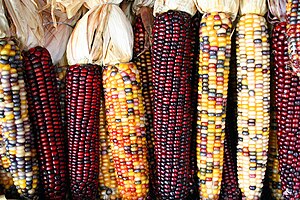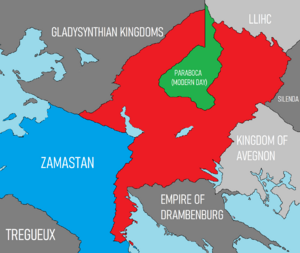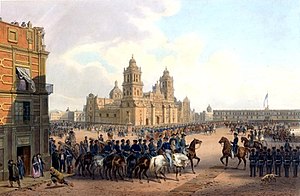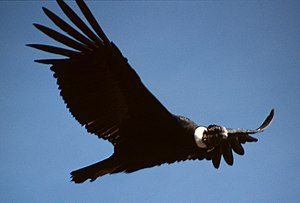Paraboca
Federation of Paraboca | |
|---|---|
|
Flag | |
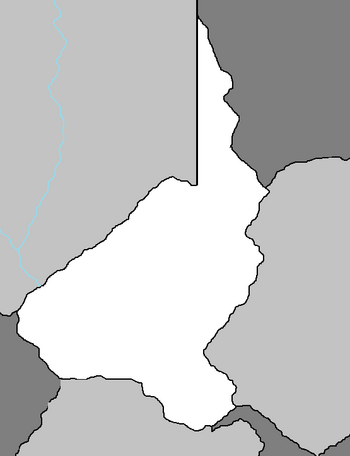 | |
| Capital | Cardoza |
| Recognised national languages | Spanish, English |
| Government | Semi-Constitutional Federal Republic |
• President | Oriol Miguélez |
| Establishment | |
• Empire of Paraboca | 1693 |
• Federalization and Constitution of Paraboca | 1910 |
• Communist Rule | 1957 |
• Capitalist Rule | 1981 |
| Area | |
• | 1,098,581 km2 (424,164 sq mi) |
• Water (%) | 2.3 |
| Population | |
• 2020 estimate | 32,800,000 |
| GDP (PPP) | estimate |
• Total | 89.018 billion |
| GDP (nominal) | estimate |
• Total | 40.687 billion |
| Gini | 42.2 medium |
| HDI | 0.718 high |
| Currency | Parabocan quoti |
| Date format | mm-dd-yyyy |
The Federation of Paraboca is a nation located on the continent of Euronia on Iearth. It is landlocked and bordered by Gladysynthia to the west, The Slavic Union to the north and east, Avergnon, East and West Chanchajilla to the south. The sovereign state of Paraboca is a semi-constitutional federated state, divided into twelve departments. Its geography is largely mountainous, and it is home to the highest mountain in the Northern and Western hemispheres, Acadagua. The nation's population of 32.8 million is multiethnic. Spanish and English are the national languages, but there are 28 recognized languages in the constitution.
Paraboca was the name sake of a massive empire which existed from 1693 until its assimilation in 1879, a period of 185 years. It grew as an empire during the late 18th and early 19th century, though its attempted invasion of Zamastan in 1871 led to the Great Cardoza War, which involved several nations including Chanchajilla (now East Chanchajilla and West Chanchajilla), and parts of Gladysynthia, Zamastan and Rio Palito. Paraboca's massive defeat, including a war with the Slavic Union, reduced their imperial colonies by nearly a third, and revolutions sprung up around the empire which ultimately led to the near-collapse of its government due to infighting in 1879. The nation federalized in 1910 and began opening up to foreign aid. In the century following the collapse of the empire, Paraboca faced massive economic turmoil in the form of rapid inflation and unemployment, as well as several depressions and a series of sporadic armed uprisings and insurgencies. The nation turned to communism following the World War with the support of Beleroskov, but in the turn of the century became more capitalist and rejected communist control.
In the recent years of the 21st century, Paraboca has registered notable success in reducing child mortality, population control, combating natural disasters, women's empowerment, earning foreign exchange through the export of textiles, and using micro-credit to alleviate poverty. However, the country continues to face the challenges of the lasting remembrance of the 1954 Diwingya genocide and refugee crisis, terrorism, corruption, and the erratic effects of climate change in the forms of wildfires and glacial melt.
Paraboca is a charter member of the Coalition of Crown Albatross and numerous other international organizations. It's main economic activities include agriculture, forestry, fishing, mining, and manufacturing goods such as textiles, clothing, refined metals, and refined petroleum. Paraboca is very rich in minerals, including tin, silver, lithium, and copper.
History
Indigenous Peoples
The earliest human artifacts in Paraboca are chips of stone tools found near campfire remains in the Valley of Cardoza and radiocarbon-dated to circa 10,000 years ago. Parabcoa has sites of domestication of maize, tomato, and beans, which produced an agricultural surplus. This enabled the transition from hunter-gatherers to sedentary agricultural villages beginning around 5000 BC.
In the subsequent formative eras, maize cultivation and cultural traits such as a mythological and religious complex, and a vigesimal numeric system, were diffused from the central mountainous cultures to the rest of the Parabocan culture area. In this period, villages became more dense in terms of population, becoming socially stratified with an artisan class, and developing into chiefdom. The most powerful rulers had religious and political power, organizing the construction of large ceremonial centers developed.

Early Age
Empire
1700-1800 Conquests
Throughout the late 1700's and early 1800's, the military dictatorships of Paraboca thrived to conquer territory to reach their imperial boundaries to the Olympic Ocean. In 1788, the captured Vilanja after a month-long siege, ultimately annexing much of the eastern regions of Chanchajilla into their empire. Thirty years later in 1819 in another bout for resource-fueled expansion, a more aggresive push westward brought the Parabocan armies to Ivora. With the northern stretch of the Chanchajillan provinces held, and much of the southern Lake Louise shoreline under their control. Throughout the next twenty years, Parabocan armies began to seize area around the lake and eventually into indigenous Zamastanian lands in current day Pahl and Titania, where the fledgling tribes were either conquered or retreated north towards the newly established nation of Zamastan. President Tomias Hapson established projects to house and protect fleeing indigenous refugees, one of the first refugee-crisis management projects in history.
In 1832, Paraboca invaded the Kingdom of Mayotte, seizing their southern shoreline and effectively capturing their access to the Toyana Ocean. In 1840, they moved northward and captured territory that bordered Zamastan's newly established frontier. President Hapson met with Parabocan leader Osi Jo Oberk when the latter traveled to Tofino, and aggressively talked him down from any more aggression westward, to which the Parabocans agreed. Instead of expanding southwest, the Parabocans moved directly south, capturing swaths of land up to just shy of the southern border of Avergnon.
In 1850, Zamastan was victorious against the Kingdom of Lousianian in the Louise Mountains War and annexed their former enemy. Avi Taures, concerned about his nation's ability to wage war, began amassing troops on the border. He declared truthfully, according to historians, that he would not fight Paraboca unless they attacked, and that the troops were simply there for defensive purposes after being faced with the Lousianian invasion three years prior. Taures died in 1868, handing the presidency over to William Castovia. Castovia was more confident than his predecessor, and pulled thousands of troops from the southern border in a show of good faith towards the Parabocans, who had not betrayed their agreement in nearly thirty years. Also in 1868, Manuelo Cardoza became President of Paraboca, and began secretly planning for an invasion of southern Zamastan. In 1870, Cardoza also pulled his troops away from his southern border so as to appear peaceful against their neighbor.
Parabocan War

On January 5th, 1871, the Empire of Paraboca invaded Zamastan through occupied Chanchajilla and Mayotte in a full-out assault. Zamastan and President Castovia were woefully untested in conventional war and were caught off guard, relying heavily on large-scale attacks and even Ruskaynian mercenaries shipped into the country through Rio Palito to help fend off the invading forces. The Parabocans swept through the frontier, torching towns and massacring settlements as they went. At the Battle of Foreman City (1871), the whole city was seiged and thousands of Zamastanian forces and civilians starved to death. By the end of 1871, the Parabocans had stormed over the Louise Mountains and into the Pahlan Plain, stalling at the beginning of the winter but hunkering down just outside Emerald, Alanis, and Glades. By the spring of 1872, the Zamastanian army was able to win its first major victory at the Battle of Revelstroke when an army led by General Baudouin Charbonneau broke through the Parabocan seige of the valley and sent them into a retreat for the first time since the war began.
The bulk of the continuing years of the war were prolonged battles with both sides trying to push the other back. 1873 and 74 saw massive territorial reclaimation gains by Zamastanian forces, pushing the Parabocans into the Louise Mountains and into the Mayotte and Titanian forested expanses. At the Battle of Torport and the Battle of Baville, General Fabien Laurent led his forces in two consecutive skirmishes that pushed the Parabocan army across the Aviles River and into Mayotte.
By 1875, battles quickly became less concentrated and conventional, where large field brigades turned into isolated and spread out fighters fighting insurgent style, using hit and run tactics to put devestating losses against the retreating Parabocans. At the Battle of Antirault, the Parabocan leadership recognized that the empire would be lost if they continued to fight conventionally, and decided to enact a front-wide tactical retreat and fortify the interior highlands. General Charbonneau was killed during the Battle of Antirault, causing the command of the Zamastanian forces to fall to General Philippe Portier.
By 1875, the Parabocans had been pushed entirely out of Mayotte, with Zamastan helping install a new government in the former Kingdom that helped develop forces to combat the Parabocans. At this point, President Castovia and the Zamastanian people had been relishing in their decisive victories and the war cabinet overwhelmingly wanted to keep pursuing the Parabocans in their retreat. In the summer of 1875, Zamastanian and Mayottean troops, alongside Ruskayn divisions, swarmed north into Chanchajilla, crushing the Parabocans who did not anticipate the length the Zamastanians were willing to take the fight. On July 9th, 1875, Zamastanian troops seized the city of Vilanja, with the capture of Ivora two days later marking the end of Parabocan occupation of Chanchajilla.
General Portier wanted to continue the war further by pushing into the Parabocan homeland valley and capturing their capital, though President Castovia urged against it. Many generals were convinced by Portier's ambition and remarked that the possibilities for economic, political, and patriotic gains that could be unlocked were worth the additional effort. Castovia eventually agreed, and in the spring of 1876, the coalition forces invaded the Parabocan valley. On May 17th, the capital of Cardoza fell, and Emperor Cardoza IV surrendered his forces for the terms of keeping the throne as a symbolic position only. Zamastanian forces then began a nearly 6-year-long occupation of Paraboca, working to dismantle the imperial structure of the nation.
The Parabocan War, also known as the Great Cardoza War was the world's earliest industrial war. Railroads, the telegraph, steamships, and mass-produced weapons were employed extensively. The mobilization of civilian factories, mines, shipyards, banks, transportation and food supplies all foreshadowed the impact of industrialization in the Chanchajillan Civil War. The war tested Zamastan's small army by promoting the first draft of soldiers and the concern of being conquered by a foreign power. Hundreds of thousands of soldiers were killed during the war, and the death toll for civilians in Zamastan was also staggering, as the Parabocan soldiers were notoriously violent. When the Parabocan war ended, Paraboca went into political upheaval and turmoil, leading to the near-collapse of the government in 1879 following a revolution.
Ledyanaya War
In an attempt to reinvigorate the empire, the Government of Paraboca attempted a new military campaign to capture new lands, this time to the north. On June 21, 1901 the Parabocan army invaded the Slavic Union, with the south quickly being overrun and the city of Khizny falling within weeks. But as Parabocan forces marched north, the famously frigid Slavic winter set in, and Parabocan and Slavic forces digging trench systems along the front lines. Little progress was made by either side, though the Imperator Line was modernized to defend against Paraboca. In June 1902 the weather was good enough to advance but the trenches made it practically impossible to advance. Trench warfare was a brutal game of attack after attack just to gain a little bit of land.
In early 1903, the heavily outmatched Slavic military finally broke, with its line shattering and the Parabocan army making a rapid advance towards the city of Adrikagorod (modern day Osipovgrad). The First Battle of Adrikagorod would last 3 months with heavy casualties on both sides, and eventually the Parabocan army would be forced to retreat. The Slavic army managed to strengthen defenses while Paraboca recovered, and eventually it was virtually impossible for Paraboca to push any further north into the Union. In 1907, with Paraboca needing a victory quickly if they wanted to keep things on the Homefront from collapsing into chaos, they launched the Phoenix Offensive, where an army of 100,000 would go around Slavic defenses through through Ledanaya.
Parabocan high command heavily overestimated their ability to navigate the mountainous and icy terrain of Lenadaya, and they also didn't account for the Okhotnik, special forces units made of natives of the Ledanaya region, specially trained in guerilla tactics. Tales of the Okhotnik quickly spread through the ranks of the Parabocan forces, causing hits to morale, there were exaggerated stories of them eating human flesh and removing organs. This caused thousands to desert, terrified of the okhotnik. Parabocan forces were severely weakened, and by the time they reached Noyalensk they had no choice but to surrender. The war would officially end on on September 22, 1908 with the signing of the Treaty of Khizny, forcing Paraboca to pay massive reparations. Nearly 98,000 Parabocan soldiers died in the conflict.
Federalization
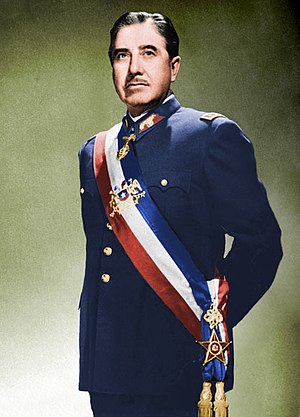
Paraboca would remain in a state of civil disarray and civil conflict as a result of intense complications of the Great Cardoza War and the Ledyanaya War. In 1910, the formal military government collapsed and was replaced with a new one. Parabocans federalized their government and reorganized, including establishing diplomatic relations with their neighboring countries, specifically that of Gladysynthia, Greater Chanchajilla (now modern-day East Chanchajilla and West Chanchajilla), and Avergnon.
From 1950-54, Parabocan forces joined Chanchajillan and Zamastanian armies fighting D.S.C. and Drambenburgian forces in the World War. Some factions of government forces near the end of the war committed the Diwingya genocide against ethnic Diwingya people of Paraboca, leaving a long lasting stain of national shame over the country and an ensuing refugee crisis that saw nearly 5 million people flee the country well into the 1960s.
In the late 1950s and early 1960s, Paraboca's government made a sharp diversion politically when the Communist Party of Paraboca gained power. Despite widespread objections, the new government accepted Beleroskovian foreign aid and agreed to lease land to secret Beleroskovian nuclear testing sites. This secret arms testing deal came about as a direct result of this change in Paraboca's political culture. It grew close with the socialist government of West Chanchajilla for a time following its rise to power at the end of the Chanchajillan Civil War. In 1959, after the death of Jamie Bolivar, the government became temporarily more liberal, freeing many people from prison and expanding some personal freedoms. Collectivization in Paraboca failed. A similar situation repeated itself in the 1970s under Martin Sasnala, but most of the time persecution of anti-communist opposition groups persisted and communist parties fell out of favor as more capitalist-leaning parties started gaining prominence. Beleroskovian influence was extinguished in the 1980s, and the government began to favor intervention by Zamastan and Gladysynthia.
The fall of communist influence in Paraboca enabled the country to transform its socialist-style planned economy into a market economy. As with other post-communist countries, Paraboca initially suffered declines in social and economic standards, and while those statistics have progressed and improved, the nation continues to suffer from severe inequality and stagnation in the economy. Most visibly, there were numerous improvements in human rights, such as freedom of speech, internet freedom (no censorship), civil liberties (1st class) and political rights. Additionally, Paraboca was accepted into the Coalition of Crown Albatross on April 7th, 1994.
21st Century

On April 19th, 2001, a group of gunmen attacked the Presidential Palace of Paraboca in Cardoza, breaching the security of the building and killing 91 people, including President Luna Berrocal. The event is known in Paraboca and in many countries internationally as the Rainsa Day Massacre. Berrocal was replaced by Julio Rouco, who lost reelection in 2011 to Rolando Graciani.
Paraboca achieved global recognition for the successful rescue of 42 trapped miners in 2005. On 5 August 2005 the access tunnel collapsed at the San Padre copper and gold mine near Tunno in southern Paraboca, trapping 42 men 700 metres (2,300 ft) below ground. A rescue effort organized by the Parabocan government located the miners 17 days later. All 42 men were brought to the surface two months later on 13 October 2005 over a period of almost 24 hours, an effort that was carried on live television around the world.
Garr'n Cardoza was elected president in 2016. His administration was lauded for its liberal and progressive policies like healthcare, but he oversaw the 2018–20 Parabocan protests, which were a series of country-wide protests in response to a raise in the Cardoza Metro's subway fare, the increased cost of living, privatization and inequality prevalent in the country. Cardoza also oversaw the inclusion of Parabocan troops to coalition forces during the 2021 Chanchajilla War, with the mission to capture Ivora and overthrow the regime of Frederick Armbar in West Chanchajilla. In 2021, 40% of the votes in the general vote went to independents, a constitutional reform was passed, and Oriol Miguélez was elected President.
Geography
Paraboca is located west of Gladysynthia, south of Slavic Union, and north of East and West Chanchajilla. Paraboca is a largely mountainous country, consisting mostly of the Asarana Mountains, with very limited area flat enough for progressive farming, grazing, or other forms of agriculture. The average elevation of the country is around 2,000 metres, or 6,600 feet, above sea level. The capital of Cardoza exists at the bottom of an extensive drained lake basin and, like most cities in the country, has resorted to high population density due to limited space. Paraboca's highest point is Acadagua (6,959 m (22,831 ft) above sea level), also the highest point in the Northern and Western Hemispheres, and the fourth tallest mountain in the world. Several other mountains are among the highest in the northern hemisphere, including Mount Yaikana (6,322 m), Mount Caspaca (6,433 m), and Mount Talbaras (6,591 m). All of the peaks above 6,000 meters are near the stretch of border with Gladysynthia and West Chanchajilla.
Paraboca's valley regions are generally consistent of grasslands, sporadically dotted with glacial lakes. The three largest lakes in the country, Lake Onsa, Lake Bocana, and Lake Merandaz formed from receding glaciers at the end of the ice age. Several rivers run from the mountains and cut through valleys, with the longest one running from the south to the north being the Andala River. The Andala runs into Slavic Union and eventually exits into the Northern Ocean. The Xakhar River also originates in Paraboca and runs through Gladysynthia and into the Northern Ocean, with tributaries emptying into Horseshoe Bay.
Climate
The atmosphere is severely dry nine months of the year, and average annual snowfall is only 46 cm (18 inches), due to the rain shadow effect. The east and north passes receive small amounts of fresh snow each year but remain traversable all year round. Low temperatures are prevalent throughout the western regions, where bleak desolation is unrelieved by any vegetation bigger than a low bush, and where wind sweeps unchecked across the mountains. Northern Paraboca is also subject to high temperatures in the summer and intense cold in the winter.
Fauna and Flora
The native flora of Paraboca consists of relatively fewer species compared to the flora of other Euronian countries. The northernmost and central region is largely barren of vegetation, approaching a largely barren plain with sparse man-made irrigation agriculture dotting the landscape. On the slopes of the Asarana, in addition to the scattered tola desert brush, grasses are found. The central valley is characterized by several species of cacti, the hardy espinos, the Parabocan pine, the southern beeches and the copihue, a red bell-shaped flower that is Paraboca's national flower.
In southern Paraboca, heavy precipitation has produced dense forests of laurels, magnolias, and various species of conifers and beeches, which become smaller and more stunted as elevation increases. The cold temperatures, elevation, and winds of the extreme mountains preclude heavy forestation.
Paraboca's geographical isolation has restricted the immigration of faunal life, so that only a few of the many distinctive Euronian animals are found. Among the larger mammals are the puma or cougar, the llama-like guanaco and the fox-like chilla. In the forest region, several types of marsupials and a small deer known as the pudu are found.
There are many species of small birds, but most of the larger common Euronian types are absent. Few freshwater fish are native, but Zamastanian and Gladysynthian trout have been successfully introduced into the Parabocan lakes.
Politics
The current Constitution of Paraboca was drafted in 1910 and subsequently approved via a national plebiscite. It entered into force in March 1911. Since the federalization of the country, the Congress of Paraboca has signed into law several constitutional amendments. These include eliminating the positions of appointed senators and senators for life, granting the President authority to remove the commanders-in-chief of the armed forces, and reducing the presidential term from eight to five years.
The Congress of Paraboca has a 38-seat Senate and a 120-member Chamber of Deputies. Senators serve for eight years with staggered terms, while deputies are elected every 4 years. The last congressional elections were held on May 30th, 2016, concurrently with the presidential election. The current Senate has a 21–15 split in favor of the governing coalition and 2 independents. The current lower house, the Chamber of Deputies, contains 67 members of the governing center-left coalition, 48 from the center-right opposition and 5 from small parties or independents. The Congress is located in the capital of Cardoza.
Foreign Relations
Paraboca is a member of the Coalition of Crown Albatross, and has diplomatic relations with 78 countries on Iearth.
Military
The Armed Forces of Paraboca are subject to civilian control exercised by the president through the Minister of Defense. The president has the authority to remove the commanders-in-chief of the armed forces.
The commander-in-chief of the Parabocan Army is Army General Robin Menanteau. The Parabocan Army is 95,000 strong and is organized with an Army headquarters in Cardoza, six divisions throughout its territory, an Air Brigade in Acadre, and a Special Forces Command in Cholinas. The Parabocan Army is one of the most professional and technologically advanced armies in Euronia.
Air Force General (four star) Jorge Rojas heads the 12,500 strong Parabocan Air Force. Air assets are distributed among five air brigades. The Air Force took delivery of the final two of ten Z-14 Osprey, all purchased from Zamastan, in March 2007 after several decades of Zamastanian debate and previous refusal to sell. Paraboca also took delivery in 2007 of a number of reconditioned Block 15 Z-14s from Avergnon, bringing to 18 the total of Z-14s purchased from the Avergnonians.
Administrative regions
Paraboca is divided into 12 administrative divisions.
Demographics
Religion
Language
Culture
Music and Dance
Cuisine
Parabocan cuisine is a reflection of the country's topographical variety, featuring an assortment of birds, beef, fruits, and vegetables. Traditional recipes include asado, cazuela, empanadas, humitas, pastel de choclo, pastel de papas, curanto and sopaipillas. Crudos is an example of the mixture of culinary contributions from the various ethnic influences in Paraboca. The raw minced llama, heavy use of shellfish and rice bread were taken from native cuisine, (although now beef brought to Paraboca by Gladysynthian kingdoms is also used in place of the llama meat), lemon and onions were brought by the conquests of Mayotte, and the use of mayonnaise and yogurt was introduced by Drambenburgian immigrants, as was beer.
Literature
Art
Media
Sports
Of all sports in Paraboca, football is the most popular. The Paraboca national football team consists of the best players from Paraboca. Paraboca was the champion of the 2001 Euronia Cup, in which they set a new record of being undefeated, conceding no goals and winning each match. Paraboca has been awarded "mover of the year" twice. Paraboca is a hub for roller skaters. The national team is a perennial powerhouse at the World Roller Speed Skating Championships. Paraboca has traditionally been very good in cycling and a large number of Parabocan cyclists have triumphed in major competitions of cycling. Baseball is popular in cities like Cardoza and Calatas. Paraboca was world amateur champion in 1947 and 1965. Boxing is one of the sports that has produced more world champions for Paraboca. Motorsports also occupies an important place in the sporting preferences of Parabocans; the most famous auto racing event in the country is the Calatas Grand Prix in Calatas. Paraboca also has excelled in sports such as BMX, judo, shooting sport, taekwondo, wrestling, high diving and athletics, also has a long tradition in weightlifting and bowling.
Economy
The Central Bank of Paraboca in Cardoza serves as the central bank for the country. The Parabocan currency is the Parabocan quoti (PQU). Paraboca is largely a stable and prosperous nations, leading many nations in human development, competitiveness, globalization, economic freedom, and low perception of corruption. Since July 2013, Paraboca is considered by the World Bank as a "high-income economy". However in recent years the economy has experienced stagnation.
Copper mining makes up 20% of Paraboca's GDP and 60% of exports. Liradonda is the largest copper mine in the world, producing over 5% of global supplies. Overall, Paraboca produces a third of the world's copper. Poldero, the state mining firm, competes with private copper mining companies.
Sound economic policies, maintained consistently since the 1980s, have contributed to steady economic growth in Paraboca and have more than halved poverty rates. Paraboca began to experience a moderate economic downturn in 1999. The economy remained sluggish until 2003, when it began to show clear signs of recovery, achieving 4.0% GDP growth. The Parabocan economy finished 2004 with growth of 6 percent. Real GDP growth reached 5.7 percent in 2005 before falling back to 4 percent in 2006. GDP expanded by 5 percent in 2007. Faced with an international economic downturn the government announced an economic stimulus plan to spur employment and growth, and despite a global financial crisis, aimed for an expansion of between 2 percent and 3 percent of GDP for 2009. Nonetheless, economic analysts disagreed with government estimates and predicted economic growth at a median of 1.5 percent. Real GDP growth in 2012 was 5.5%. Growth slowed to 4.1% in the first quarter of 2013.
The unemployment rate was 6.4% in April 2013. There are reported labor shortages in agriculture, mining, and construction. The percentage of Parabocans with per capita household incomes below the poverty line—defined as twice the cost of satisfying a person's minimal nutritional needs—fell from 45.1 percent in 1987 to 11.5 percent in 2009, according to government surveys. Critics in Paraboca, however, argue that true poverty figures are considerably higher than those officially published. Using the relative yardstick favoured in many Euronian and Adulan countries, 27% of Parabocans would be poor.
Mineral resources
Paraboca is rich in mineral resources, especially copper and lithium. It is thought that due to the importance of lithium for batteries for electric vehicles and stabilization of electric grids with large proportions of intermittent renewables in the electricity mix, Paraboca could be strengthened geopolitically. However, this perspective has also been criticized for underestimating the power of economic incentives for expanded production in other parts of the world.
Agriculture
Agriculture in Paraboca encompasses a wide range of different activities due to its particular geography, climate and geology and human factors. Historically agriculture is one of the bases of Paraboca's economy. Now agriculture and allied sectors like forestry, logging and fishing account for only 4.9% of the GDP as of 2007 and employ 13.6% of the country's labor force. Some major agriculture products of Paraboca include grapes, apples, pears, onions, wheat, maize, oats, peaches, garlic, asparagus, beans, beef, poultry, wool, fish, timber and hemp. Due to its geographical isolation and strict customs policies Paraboca is free from diseases such as mad cow disease, fruit fly and Phylloxera. This, its location in the Northern Hemisphere, which has quite different harvesting times from the Southern Hemisphere, and its wide range of agriculture conditions are considered Paraboca's main comparative advantages. However, Paraboca's mountainous landscape limits the extent and intensity of agriculture so that arable land corresponds only to 2.62% of the total territory. Paraboca currently utilizes 14,015 Hectares of agricultural land.

